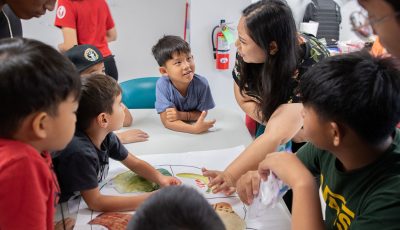Forestry memorandum signed to help program delivery
HONOLULU—There’s a breeze of fresh air! A formal partnership was recently recognized as a collaboration on forestry related technical assistance and program delivery in American Samoa.
The U.S. Department of Agriculture’s Natural Resources Conservation Service and the U.S. Forest Service signed a memorandum of understanding with the American Samoa Soil and Water Conservation District and the American Samoa Community College. While all four MOU partners support forest management and conservation in American Samoa, each has varying levels of staffing, technical expertise, facilities and funding capacity. The purpose of this MOU is to strengthen cooperation and coordination among the Partners to better protect, conserve and enhance benefits from American Samoa’s private and communal (non-federal) forest and agroforest lands.
This agreement will:
– Describe ongoing cooperation between the partners so that it will continue even as individual staff members, volunteers and others may change;
– Clarify local applications of cooperative activities authorized by national programs so that local partners may proceed with confidence; and
– Commit to pursuing additional forms of cooperation.
“NRCS has a significant amount of capability in identifying landowners interested in forestry practices,” said Christine Clarke, acting director for the NRCS Pacific Islands Area. “We would benefit from a relationship that ensured that all parties’ goals are met.”
“This will be another valuable partnership as we continue to explore new ways to accomplish collaborative Ecological Restoration work,” said Randy Moore, regional forester for the Pacific Southwest Region of the U.S. Forest Service. “This MOU is an example of what can happen when people work toward a common vision without boundaries in an all-lands approach.”
“The American Samoa Soil and Water Conservation District is honored to cooperate with the partners of the Forestry MOU,” said Ma’anaima Fuala’au, ASSWCD chairman. “This MOU will definitely promote interagency delivery of forestry-related conservation programs in American Samoa and motivate landowners to become more active in planning and managing their forests for future generation.”
“On behalf President Dr. Seth Galea’i, it’s a privilege for the American Samoa Community College Forestry Program to be a partner in the MOU,” said Tapa’au Dr. Daniel Mageo Aga, ASCC director. “We need to make the right decision to protect our forests so that our forests can protect us.”
On Sept. 26, 2013, the National Association of State Foresters, the National Association of Conservation Districts, the NRCS and the USFS updated and signed a national Joint Forestry MOU. The national MOU strengthens cooperation between the partners at the national level for coordinated interagency delivery of forestry-related conservation assistance to privately managed lands. This MOU provides specific detail on how the intent of the national MOU will be addressed in American Samoa.
The partners recognize the unique and complementary role that each partner brings to the partnership:
– The ASCC Forestry Program conducts extension, technical assistance and public education programs for landowners/land users and community groups, and provides noncash, material assistance, especially planting materials.
– The USFS recognizes ASCC as the “State Forester” of American Samoa for the purposes of USFS financial assistance to ASCC to conduct the above programs under State and Private Forestry authorities.
– The NRCS provides technical and financial assistance to private landowners to conserve the natural resources on their lands.
– NRCS and USFS are sources of interdisciplinary expertise for forestry and natural resource conservation; local staff can call upon specialists from these national agencies.
– The ASSWCD carries out natural resource management at the Territorial level and acts as a liaison between private landowners and government assistance programs.
– Landowners voluntarily request assistance from the Partners and are the decision makers for their land.
To learn more about USDA, visit http://www.fs.usda.gov/main/r5/communityforests or www.pia.nrcs.usda.gov for more information. (USDA)



























